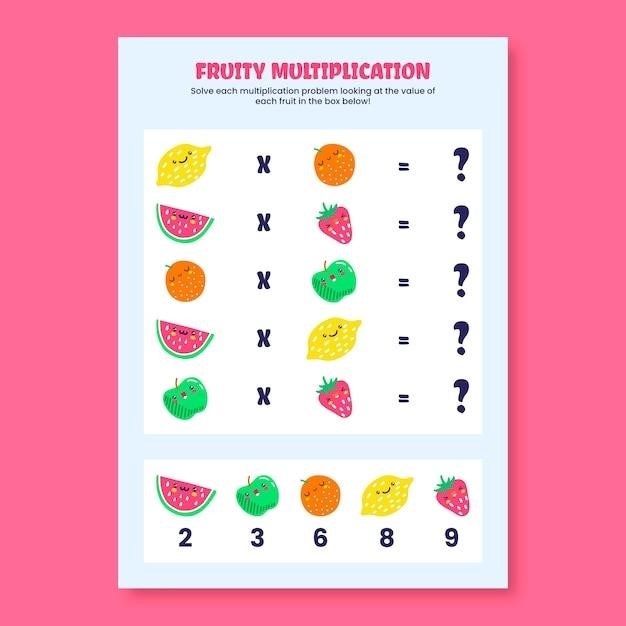Simple Interest Worksheets with Answers PDF⁚ A Comprehensive Guide
Simple interest worksheets are a valuable tool for students learning about basic financial concepts. These worksheets provide practical examples of how simple interest is calculated and applied in real-world scenarios. They offer a structured approach to understanding the principles of simple interest, helping students develop their problem-solving skills and gain confidence in their financial literacy.
Introduction to Simple Interest
Simple interest is a fundamental concept in finance that involves calculating interest only on the principal amount of a loan or investment. It’s a straightforward method of calculating interest earnings or loan costs, making it an ideal starting point for understanding financial concepts. Simple interest is often applied to short-term loans, such as automobile loans or personal loans, as well as certain types of savings accounts. Understanding simple interest is crucial for individuals and businesses alike, as it forms the foundation for more complex financial calculations. In essence, simple interest helps individuals understand how their money grows over time when invested or how much they owe on a loan.
Simple interest worksheets provide a hands-on approach to learning about this concept. These worksheets typically present various scenarios involving loans, investments, and interest calculations, allowing students to apply the simple interest formula and practice their problem-solving skills. By working through these worksheets, students gain a deeper understanding of the mechanics of simple interest and its real-world applications. This knowledge empowers them to make informed financial decisions and navigate various financial situations confidently.
Understanding the Formula
The formula for simple interest is relatively straightforward and easy to grasp. It involves multiplying the principal amount (P) by the interest rate (r) and the time period (t). The formula can be expressed as⁚
Simple Interest (I) = P * r * t
Where⁚
- I represents the simple interest earned or paid.
- P represents the principal amount, which is the initial amount borrowed or invested.
- r represents the interest rate, expressed as a decimal (e.g., 5% is represented as 0.05).
- t represents the time period, typically expressed in years.
For instance, if you invest $1000 at a simple interest rate of 5% for 3 years, the simple interest earned would be⁚
I = $1000 * 0.05 * 3 = $150
This means that after 3 years, you would earn $150 in simple interest on your initial investment of $1000.
Types of Simple Interest Problems
Simple interest worksheets typically present various types of problems to help students understand different aspects of simple interest calculations. Common problem types include⁚
- Calculating Simple Interest⁚ These problems provide the principal amount, interest rate, and time period and ask students to calculate the simple interest earned or paid. This type of problem helps students understand the basic application of the simple interest formula.
- Finding the Principal Amount⁚ These problems provide the simple interest earned, interest rate, and time period and ask students to calculate the original principal amount. This type of problem helps students develop their problem-solving skills by rearranging the simple interest formula.
- Determining the Interest Rate⁚ These problems provide the principal amount, simple interest earned, and time period and ask students to calculate the interest rate; This type of problem enhances students’ understanding of the relationship between interest rate and the amount of interest earned.
- Calculating the Time Period⁚ These problems provide the principal amount, simple interest earned, and interest rate and ask students to calculate the time period over which the interest was earned. This type of problem helps students apply the simple interest formula in a slightly different context.
By working through these diverse problem types, students gain a comprehensive understanding of simple interest concepts and develop the ability to solve various real-world financial scenarios.
Simple Interest Worksheet Examples

Simple interest worksheets typically include a variety of problems that showcase different aspects of simple interest calculations. Here are a few examples⁚
- Problem 1⁚ Calculate the simple interest earned on a principal amount of $500 invested at an annual interest rate of 6% for 3 years.
- Problem 2⁚ A loan of $2000 is taken out at an interest rate of 7% per year. If the simple interest accrued is $560, how long was the loan taken out for?
- Problem 3⁚ A bank account earns simple interest at a rate of 3% per year. If $200 is invested in the account and $6 is earned in interest, for how many months was the money invested?
- Problem 4⁚ A person invests $10,000 in a savings account that pays simple interest at a rate of 4% per year. How much interest will they have earned after 5 years?
- Problem 5⁚ A car loan of $15,000 is taken out at an interest rate of 5% per year. What is the total amount of interest paid over a 4-year loan term?
These examples provide a glimpse into the types of problems students may encounter on simple interest worksheets. The worksheets often include space for students to show their work and arrive at the correct solutions.
Creating Your Own Worksheets
Creating your own simple interest worksheets can be a fun and rewarding experience. It allows you to tailor the content to your specific needs and learning objectives. Here’s a step-by-step guide⁚
- Determine the Skill Level⁚ Consider the age and understanding of the learners. Choose problems that align with their current knowledge base and gradually introduce more complex concepts.
- Define the Scope⁚ Decide on the specific topics you want to cover. This could include basic calculations of simple interest, finding the principal, rate, or time, or even applying simple interest to real-world scenarios like loans or investments.
- Create the Problems⁚ Craft a variety of problems with different levels of difficulty. Use realistic scenarios to make the learning process more engaging.
- Provide Solutions⁚ Include the correct answers to each problem, either directly on the worksheet or in a separate answer key. This allows students to check their work and identify areas where they need further clarification.
- Format and Design⁚ Choose an attractive and easy-to-read format for your worksheet. You can use a word processing program or online tools to create professional-looking documents.
- Test and Refine⁚ Before distributing your worksheets, test them out yourself or with a small group of students. This allows you to identify any errors or areas that need improvement.
By following these steps, you can create effective and engaging simple interest worksheets that help students master this important financial concept.
Benefits of Using Simple Interest Worksheets
Simple interest worksheets offer a multitude of benefits for students and educators alike, making them a valuable tool for enhancing financial literacy and problem-solving skills. Here are some key advantages⁚
- Reinforce Fundamental Concepts⁚ Worksheets provide a structured and repetitive approach to understanding simple interest calculations, helping students solidify their grasp of the underlying principles.
- Develop Problem-Solving Skills⁚ Simple interest problems require students to apply formulas, interpret data, and make logical deductions, fostering their critical thinking and problem-solving abilities.
- Promote Independent Learning⁚ Worksheets allow students to work independently at their own pace, allowing them to explore concepts and develop their understanding without the constant need for direct instruction.
- Offer Immediate Feedback⁚ The inclusion of answer keys provides immediate feedback to students, enabling them to identify areas where they need to review or seek assistance.
- Enhance Real-World Relevance⁚ By incorporating real-world scenarios like loans, investments, and savings accounts, simple interest worksheets connect abstract concepts to practical applications, making learning more engaging and meaningful.
Overall, simple interest worksheets serve as a valuable tool for promoting financial literacy and fostering essential skills that students can apply in their academic and personal lives.
Simple Interest Worksheets for Different Grade Levels
Simple interest worksheets are adaptable to various grade levels, allowing educators to tailor the content and complexity to suit the specific needs of their students. Here’s a breakdown of how these worksheets can be effectively used across different age groups⁚
- Elementary School (Grades 4-6)⁚ Worksheets for younger students can focus on basic concepts, introducing simple interest through real-world examples like saving money in a piggy bank or borrowing from a friend. Problems should involve smaller amounts and simpler calculations, gradually increasing in complexity as students progress.
- Middle School (Grades 7-8)⁚ Worksheets for middle school students can introduce more complex scenarios, including calculating interest on loans, investments, and savings accounts. Problems can involve larger amounts, multiple interest rates, and different time periods, allowing students to develop a deeper understanding of the concept.
- High School (Grades 9-12)⁚ Worksheets for high school students can delve into more advanced applications of simple interest, including compound interest, amortization, and the time value of money. Problems can involve real-world scenarios like mortgages, car loans, and retirement planning, preparing students for practical financial decisions.
By adjusting the level of difficulty and complexity, simple interest worksheets can be a valuable resource for teaching financial literacy across all grade levels, empowering students with the knowledge and skills they need to navigate the world of money.

Where to Find Simple Interest Worksheets with Answers
Finding high-quality simple interest worksheets with answers is easier than you might think. There are numerous online resources and educational platforms dedicated to providing teachers and students with comprehensive materials. Here are some reliable sources to explore⁚
- Educational Websites⁚ Websites like Math-Drills.com, K5 Learning, and Education.com offer a wide range of printable worksheets covering various math topics, including simple interest. These websites often provide answer keys, making it convenient for teachers and parents to assess student understanding.
- Teacher Resource Platforms⁚ Online platforms like Teachers Pay Teachers and TpT offer a vast collection of teacher-created resources, including worksheets, lesson plans, and activities. Many of these resources focus on specific grade levels and learning objectives, ensuring that the content aligns with curriculum standards.
- Textbook Publishers⁚ Many textbook publishers offer supplementary materials and online resources, including worksheets, practice problems, and answer keys, that complement their printed textbooks. These resources are often designed to reinforce key concepts and provide additional practice opportunities.
By utilizing these resources, educators can easily access a wealth of simple interest worksheets with answers, enriching their teaching materials and providing students with the necessary tools for successful learning.
Tips for Using Simple Interest Worksheets Effectively
Simple interest worksheets can be a powerful tool for teaching and reinforcing financial concepts. To maximize their effectiveness, consider these tips⁚
- Start with the Basics⁚ Begin with simple worksheets that introduce the fundamental formula for calculating simple interest (I = PRT). Gradually introduce more complex problems as students gain confidence.
- Real-World Applications⁚ Connect simple interest concepts to real-world scenarios, such as savings accounts, loans, and investments. This helps students understand the practical implications of these concepts.
- Visual Aids⁚ Use visual aids like diagrams, charts, and graphs to illustrate simple interest concepts. This can help students grasp the relationships between different variables.
- Collaborative Learning⁚ Encourage students to work together on worksheets, discussing their strategies and solutions. This promotes peer learning and critical thinking.
- Differentiated Instruction⁚ Provide differentiated instruction by offering worksheets at different levels of difficulty. This ensures that all students can succeed and progress at their own pace.
By following these tips, educators can effectively utilize simple interest worksheets to enhance student understanding and build a solid foundation in financial literacy.
Simple interest worksheets are a valuable resource for educators and students alike. These worksheets offer a structured and engaging approach to learning about basic financial concepts, helping students develop a strong understanding of simple interest calculations and their applications in real-world scenarios. By providing step-by-step guidance, worked examples, and practice problems, simple interest worksheets empower students to confidently tackle financial calculations and build essential financial literacy skills.
Whether you are a teacher looking for engaging classroom activities or a student seeking additional practice, simple interest worksheets with answers PDF are an excellent tool to enhance your understanding of this fundamental financial concept. Embrace the opportunity to explore the world of simple interest and gain valuable insights into the power of financial knowledge.


